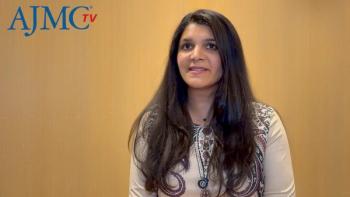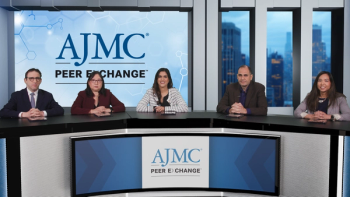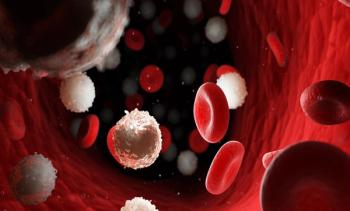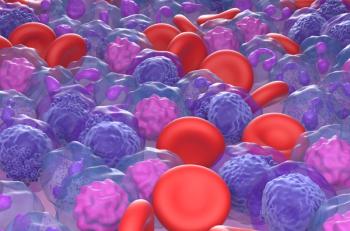
Durability, Reduced Toxicity of CAR NK Therapy in AML May Aid Curative Treatment
Key Takeaways
- SENTI-202, a CAR NK cell therapy, achieved complete remission in several relapsed/refractory AML patients, showing potential as an effective treatment option.
- The off-the-shelf nature of SENTI-202 allows for multiple infusions without manufacturing delays, reducing patient wait times and stress.
Second of 2 parts featuring an interview with Stephen Strickland, MD, MSCI,director, Leukemia Research for Sarah Cannon Research Institute. Strickland recently presented data from a phase 1 trial of SENTI-202, an investigational chimeric antigen receptor natural killer (CAR NK) cell therapy. Toxicity with this therapy is lower than seen in many conventional CAR T-cell therapies.
For patients with the fast-moving blood cancer acute myeloid leukemia (AML), the wonders of chimeric antigen receptor (CAR) T-cell therapy have been off limits. But that could be changing, after data recently presented at the
SENTI-202, a first-in-class chimeric antigen receptor natural killer (CAR NK) cell therapy, produced complete composite remission 4 of 7 evaluable patients treated thus far in a phase 1 study (
The treatment dose and schedule recommended for phase 2 is 1.5 x 109 CAR NK cells administered on Days 0, 7, and 14 in 28-day cycles following lymphodepleting chemotherapy. If patients need another cycle, that can be completed without manufacturing delays, Strickland said.
This interview is edited for length and clarity.
AJMC: Because SENTI-202 is an off-the-shelf therapy, if patients need another cycle, that can be done back-to-back without a second round of leukapheresis or a wait on the manufacturing process, which is not possible with conventional therapy. Is this correct?
Strickland: That is correct. This is unique in a couple of ways. First, it's not just a single infusion of cells. The dosing schedules that we've evaluated in this study had Schedule 1, which was 3 cellular infusions, and Schedule 2, which was up to 5 cellular infusions over a 14-day period from the first cell infusion to the last. We've demonstrated that you can give multiple infusions of these cells. We also know that NK cells likely aren’t going to persist for months and months within the patient, and they’re allogeneic cells, so the host immune system comes up, and it may eradicate that cell population. But while we have the immune system suppressed from lymphodepleting chemotherapy—the chemo that precedes the infusion—hopefully, they're primed and ready to do their job of helping to knock down and eliminate residual leukemia cells that may persist after the chemotherapy is done.
This helps us to achieve those remissions. We can give multiple infusions of the cellular product, and they are ready and waiting for the patient when the patient is in need, to help reduce the time that the patient has to wait for a product to be available. All of this is very encouraging.
The other thing I should mention is the depth of the response that is seen—first, in achieving these [minimal residual disease] negative responses, but also the durability that we've seen thus far. At the time of the data cut off, we have patients who are over 8 months out from finishing [treatment]. The first patient, for instance, who went into an MRD-negative remission—that patient is over 8 months out now. The patient did receive a stem cell transplant, but the fact that we're having good durability, and hopefully that means it's a sign that the patient is cured. But time will tell.
AJMC: Can you compare the toxicity of this approach with what we're accustomed seeing in today’s CAR T-cell therapy? We hear about cytokine release syndrome (CRS) and immune effector cell-associated neurotoxicity syndrome (ICANS) with CAR T. How does this therapy compare?
Strickland: What we’ve seen so far is a very favorable safety profile. We've not noticed any dose-limiting toxicity. We have not been limited in our schedule or our number of cell infusions, or the number of cells we get per infusion. The toxicities that we see are typically what we expect with just anyone receiving fludarabine and cytarabine, which is the lymphodepletion backbone that we use. Both those agents have antileukemic activity, so we're not just relying on them to suppress the immune system and relying only on the cells.
We're really looking at this as a package therapy, where we can enhance the activity with a 1-2 punch of the chemo plus the cell infusion to achieve better responses.
As far as tolerability, we're not really seeing significant cytokine release syndrome. Now, there are a couple of patients, as was mentioned, that were reported as early grade CRS. However, if we look more into that, we may have to redefine how we define CRS to indicate the time course in which the symptoms like fever and those things develop. It makes us wonder if it's more of an infusion-related reaction, as opposed to a true cytokine release syndrome. We'll have to do some work in order to further classify this.
These were lower grade, somewhat self-limiting patients that received standard of care. A couple of patients maybe got tocilizumab with the febrile response. I think we're now conditioned from the CAR T experience to use those agents more quickly. But whether or not those are needed for [this therapy] is unclear. Thankfully, the safety profile has been very encouraging; we’ve been able to limit this to low grade CRS.
There were grade 1 fevers, with maybe some hypotension and hypoxia, but all happened within a day of the infusion, and maybe even within hours of the infusion. We’re not seeing the neurotoxicity that can be seen with some conventional CAR T therapies.
The other question is long-term safety with a cellular product that stays in and has been engineered. There's been some recent concerns for some patients of secondary malignancies after they receive the CAR T product. Now, I'm not admonishing CAR T therapies; I think they've helped to open the door and revolutionize care, but I think that story has more to be said about over time. What we see and with a cellular product like this, we anticipate that the risk of that, albeit low overall for the other products, hopefully the risk with this product is going to be even lower.
AJMC: More and more, we are hearing physicians refer to “brain-to-vein” time, which means they are trying to reduce the number of days from the decision to go with a given therapy to the time it is administered. In a real-world setting, this would include the time to have treatment approved by a payer. Obviously, with an off-the-shelf therapy, that time is dramatically reduced. What does that do for the patient, not just therapeutically, but also from the quality of life perspective—of not having to wait weeks for manufacturing? What kind of difference does that make for the patient?
Strickland: Especially in AML, these patients have had their world turned upside down already. It’s not just them; it’s also their families. Whenever we have something that involves a significant time lag to get them to the therapy, that's a stressor on the patient when they're already stressed. And so, anything we can do to help lessen that burden helps. Obviously, what we ultimately need and want are very effective therapies. The biggest stress reliever is being able to tell a patient that that their leukemia has responded, and that they're in remission. That takes a lot of pressure off of the patient and allows them to exhale.
Many of the [hematological] malignancies are very cruel in the sense that from the time to diagnosis to the time of initiating some form of therapy, patients are just barely starting to adjust to the idea that they have cancer. In many solid tumor malignancies, the physician may say, “You have a spot on your lung or in your breast, or there's something on an X-ray.” We're going to get a scan. We're going to set you up for a biopsy. We're going to get the results of the biopsy a week or two.
In these cases, we'll say, “We're going to have you see an oncologist.” This allows the patient, and their families, to have perhaps 6 weeks or so to adjust to this idea of having cancer before treatment starts. In the world of AML, we often don't have that time.
By contrast, when we tell patient they have acute myeloid leukemia, they go to the emergency department, they are admitted to the hospital, and we start chemotherapy. That may be condensed to a week or less from the time that that they're being told they have cancer. Everything can be overwhelming and incredibly stressful.
So, for patients who either don't respond to standard therapy, or who respond but then relapse, it just it kicks everything back up. It’s an advance to have a therapy that is ready when the patient in need is identified—that’s the way I think about it. I think to cut down that lead time can alleviate an immense burden for the patient and their family, knowing that that hopefully help is on the way.
AJMC: Are we taking a matter of days from the when the decision is made to the time the patient is treated?
Strickland: In the context of the study, there are screening procedures and things of that nature. But if we could envision a product like this being commercially available right away; when a patient in need is identified—because the patient has relapsed disease or refractory disease—and we feel that they are a candidate for this therapy, it will all be about communication with the manufacturer. As we're setting up all the logistics to start the lymphodepleting chemo—or the fludarabine and cytarabine in this case—then at that point the cells can be getting shipped from the manufacturer to the treatment site. Thus, by the time the patient has finished the chemotherapy they can be ready for cell infusion, which we’ve designed to be about a week after chemotherapy starts. So if you start lymphodepleting chemo on a Monday, then the following Monday you would get the first cell infusion. That allows time to ship the cells. They can be shipped overnight, and they’ll be at the stored in the cell processing lab at the center that would be administering them. We look forward to this happening somewhat seamlessly.
AJMC: Is anything we didn't cover that you would want to add?
Strickland: Let’s circle back to the discussion of toxicity. We took note of the time frame to recovery for these patients. From the time they got the lymphodepleting chemotherapy, to the time of recovering their [white blood cell] counts, for those who responded and who we cleaned up the bone marrow, we did not see an extension of the [recovery] timeline. So, administering this product did not seem to cause further myelosuppression or delay count recovery. The count recovery was pretty much on par with what we would expect for patients just getting the flu.
Especially with targeting CD33, we theoretically could cause more myelosuppression. Hopefully, the fact that we're recovering on time is also a sign that the endomucin—this NOT gate system—is working as designed, by sparing the healthy hematopoietic cells and allowing recovery to have an appropriate time frame. We hope this will reduce the risk of infections and other complications that could arise if that process were prolonged for a significant time.
It's early, but we're seeing responses even at our first dose level and for our first dose schedule, and we're seeing deep responses. We are not seeing excessive toxicity. So far, this seems to be a safe and effective therapy for patients in relapsed/refractory, pretreated population. We're just very excited to see where it goes.
References
- Senti Bio’s SENTI-202, a first-in-class, off-the-shelf logic gated selective CD33 OR FLT3 NOT EMCN CAR NK cell therapy, demonstrates positive preliminary clinical results in the treatment of patients with R/R AML. News release. Senti Bio. April 27, 2025. Accessed April 28, 2025.
https://investors.sentibio.com/news-releases/news-release-details/senti-bios-senti-202-first-class-shelf-logic-gated-selective - Strickland S, Eghtedar A, Farhadfar N, et al. First-in-human multicenter study of SENTI-202, a CD33/FLT3 selective off-the-shelf logic gated CAR NK cell therapy in hematologic malignancies including AML: clinical data. Presented at: American Association for Cancer Research, April 25-30, 2025, Chicago, IL; abstract CT014.
- Off-the-shelf natural killer cell therapy with logic gates elicits complete remissions in relapsed or refractory blood cancers. News Release. American Association for Cancer Research. April 27, 2025. Accessed April 28, 2025.
https://www.aacr.org/about-the-aacr/newsroom/news-releases/off-the-shelf-car-natural-killer-cell-therapy-with-logic-gates-elicits-complete-remissions-in-relapsed-or-refractory-blood-cancers/
Newsletter
Stay ahead of policy, cost, and value—subscribe to AJMC for expert insights at the intersection of clinical care and health economics.













































